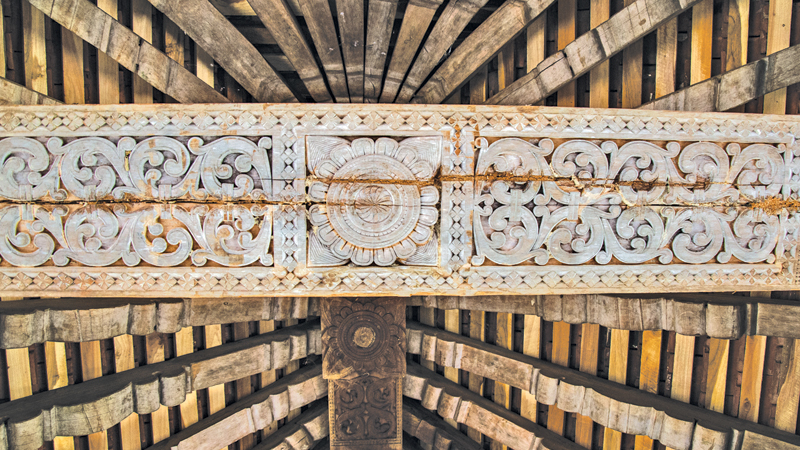 ‘Ambalama’ is a Sinhala word for a wayside rest-house. I first saw one when I was trekking to Sri Pada, (Adam’s Peak) with my grandmother in the latter part of the 1970s. I saw several buildings along the trek up to the peak where weary pilgrims stop over to take a respite from their long journey.
‘Ambalama’ is a Sinhala word for a wayside rest-house. I first saw one when I was trekking to Sri Pada, (Adam’s Peak) with my grandmother in the latter part of the 1970s. I saw several buildings along the trek up to the peak where weary pilgrims stop over to take a respite from their long journey.
Back in those days, pilgrimages and carter’s travels lasted weeks or even months. These long journeys were often by foot or by cart. Each carried his or her provisions and stopped for rest at Ambalamas constructed and designed as architecturally simple buildings for providing shelter to weary travellers free. It was also a place where travellers can rest, eat, wash and possibly stay overnight.
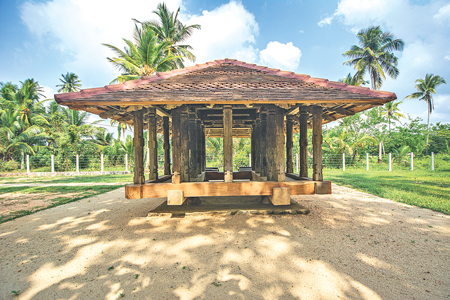
The Panavitiya Ambalama on four solid rock stones planted on the ground
Ambalama was closely linked with Sri Lankan culture and embedded in their day-to-day life. One of the brilliant scholars in Sri Lanka, Ananda Coomaraswamy, in his Medieval Sinhalese Art (1908) writes, “The Ambalama served not only as a halting place for strangers, but was generally resorted to for exchange of news and a quiet chew.”
Meeting place
Coomaraswamy said that it served as a meeting place for the Village Council (Gam-sabawa), and was intimately associated with life in the village community. There were many of these Ambalamas at no great distance apart on frequent paths, says Coomaraswamy. There were better ones in each village, erected by the villagers, or by a rich person or even a woman, anxious to perform a meritorious act.
References to the wayside rests are also found in ancient local texts as well as in the chronicles of British writer, traveller and prisoner of Kandyan Kings, Robert Knox. Ambalamas are also mentioned in Sinhala folklore.
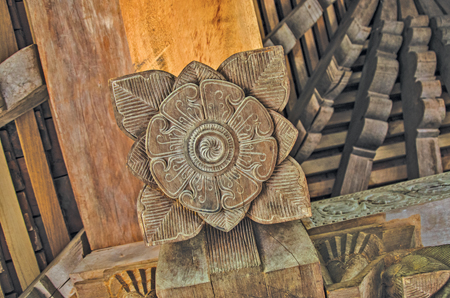
One of the carved floral designs on wooden beams on the roof
Travel itself has rapidly changed over time, and today, Ambalamas still stand along the highways reminding us of the days gone by. Recently, we had an opportunity to see one such astonishing Ambalama in the Kurunegala District. It is the Panavitiya Ambalama in a sleepy village close to Matiyagane near Narammala in Kurunegala.
After a comfortable drive down the Negombo-Kurunegala highway, before reaching Narammala town, we turned to the left, to the road that led to the Metiyagane school junction. From there we turned left, proceeded another two and a half kilometres on the wooded Dangalla Road and reached the Ambalama, on the right side in an archaeological reserve flat land adjoining the Lankathilakarama Vihara at the border of a stretch of coconut land, surrounded by lush green paddy fields. On our way to the Ambalama, we asked directions several times from villagers as it is difficult to find your way if you are a first time visitor.
As we stopped the vehicle alongside the road opposite the Ambalama and peered out at the wooden structure standing in a cleared flat land bordering a stretch of coconut cultivation, we were disappointed. In fact, for a minute we wondered if we had come to the correct place. From where we stood we could see nothing of the wood carvings that this Ambalama was famous for.
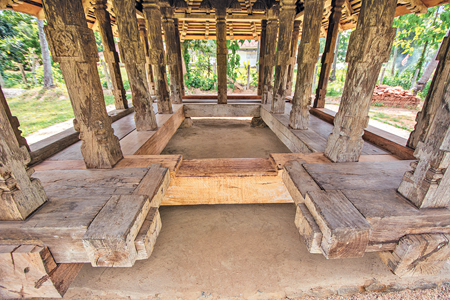
Entrance to the interior of the Ambalama
But, it didn’t take long for us to discover its wealth of wooden wonder. As we entered the Ambalama, carvings seemed to overwhelm us, covering almost every available space. The carvings are a unique combination of art themes.
Wayside shelter
According to historical notes, the Panavitiya Ambalama was built in the 18th century and it is believed that it may have stood as a wayside shelter for travellers on the ancient footpath leading from Dambadeniya to Kurunegala and Yapahuwa. It is on a wooden platform on four rounded large stones, one foot in height raised from ground level to prevent damage from termite attacks. The roof is supported by 28 wooden pillars of which nine inner wooden pillars, six inches in height, display ornate carvings and motifs. The nineteen pillars that formed the outer posts were less elaborately carved. One of the striking features of the Panavitiya Ambalama is a wooden pillar with a carving of entwined cobra hoods. This kind of wood carving is rare in Sri Lanka.
The Ambalama is famed for many finely carved pillars depicting majestic birds. Each pillar has its own individual carving. Besides the wildlife carvings, some pillars are carved with wrestling men, dancing women, musicians, acrobats, persons greeting each other and persons chanting.
The Ambalama itself is the finest living example of Sri Lankan architecture and art showcased in wood. Almost every inch of the wooden structures is decorated with elaborate, intricate carvings on rafters and beam columns. Some of these wooden pillars have been renovated by the Department of Archaeology.
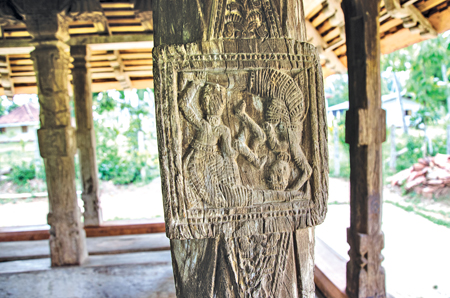
Finely carved wood carvings on one of the pillars
The value of the Panavitiya Ambalama lies in its elaborate carpentry work of beams and pillars. When I entered the Ambalama and observed the carvings, it reminded me of my visit to the Embekke Devale several months ago. Some of the Ambalama’s carvings bear resemblance to the ones at Embekke Devale at Davlagala in Kandy. Having observed the antiquity of the structure, we noticed that it has been repaired and reconstructed over the years. We understood that some of the wooden beams have been replaced in some places.
Walking around the site we found fragments of the small Kandyan Peti-ulu tiles at the site indicating that originally the roof was tiled with Peti-ulu. The Department of Archaeology has renovated and restored the roof, replacing it with modern tiles.
Magical place
Visiting this enchanting Ambalama, present day visitors can get a unique experience of the glory of the Dambadeniya Kingdom and some of the delightful wooden masterpieces of artistic creations of wood carvers of the bygone era.
Today, it stands as a unique monument of our ancient transport system. Perhaps, we were the only visitors to the site that day. I always wonder why visitors in Colombo never come here on a trip. Maybe they never knew this magical place even existed.
The road in front of the Ambalama is deserted and only used by the villagers. It is rarely approached by outsiders. We sat down on the huge beams of the Ambalama spending some time to enjoy a cup of tea with ‘Wandu’, a village sweet cake made with flour wrapped in ‘Kenda’ leaves, found abundantly in the wayside thickets.
By the way, Ambalamas still exist in Colombo too. One good example is found on the Pitakotte-Ethulkotte Road, not far from the Archaeology Department Office. It has no carvings though.



